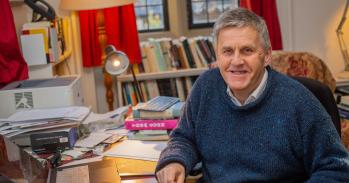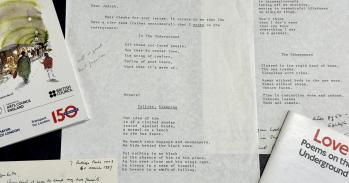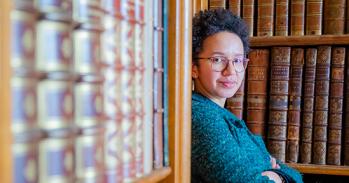
An unpublished Rupert Brooke poem will sit alongside some of Cambridge University Library’s greatest treasures when a free exhibition of highlights from its priceless collections opens to the public today.
An unpublished Rupert Brooke poem will sit alongside some of Cambridge University Library’s greatest treasures when a free exhibition of highlights from its priceless collections opens to the public today.
Cambridge University Library is one of the largest accumulations of books and manuscripts in Europe, and one of the most important in the world.
Anne Jarvis
Shelf Lives: Four Centuries of Collectors and their Books celebrates some of the men and women who have donated their libraries to Cambridge University over the past four hundred years, and the diverse and extraordinary treasures they owned. It brings together the cream of ten exemplary collections encompassing more than a millennium of the written and printed word.
The curators of Shelf Lives had plenty of material to choose from; Cambridge University Library is home to more than eight million items – stored on mile after mile of shelving inside the iconic Giles Gilbert Scott building.
Star exhibits include a hand-coloured copy of the Nuremberg Chronicle of 1493 (a chronicle of world history and one of the most magnificent printed books of the fifteenth century, with more than 1,800 woodcuts) presented by Archbishop Matthew Parker; Napoleon Bonaparte’s copy of Montaigne’s Essais from his library in exile on St Helena; an illuminated ninth-century Mercian prayer-book known as the Book of Cerne (c. 820-840); and the second oldest surviving copy of the Ecclesiastical History of the English People by the Venerable Bede (673/4-735) – the celebrated ‘Moore Bede’.
A velvet-bound sermon book belonging to Queen Elizabeth I and embroidered with her coat of arms will share the exhibition space with handwritten manuscripts by John Donne and Virginia Woolf and, perhaps more unusually, trench journals (magazines produced by troops, for troops) and military money from the Austrian-occupied zone of Italy – part of the War Reserve Collection, an extraordinary gathering of at least 10,000 pieces of First World War ephemera.
University Librarian Anne Jarvis said: “Cambridge University Library is one of the largest accumulations of books and manuscripts in Europe, and one of the most important in the world. Its holdings, though, are not a single, uniform entity, but consist of a great variety of different collections which over the centuries have come to be housed under one roof and now enrich the national heritage.”
John Wells, Exhibition Curator, explained: “For this exhibition, ten different curators have chosen ten different collectors, whose lives span the sixteenth to the twentieth centuries. It really was very difficult to narrow down the field. We had an initial long-list of 20 to 30 collections, all outstanding, which could all have justified a place in the exhibition. In fact, it would have been possible to replace almost every item in the exhibition with something of similar importance.
“What visitors will experience is really ten mini exhibitions rolled into one. They can see everything from priceless illuminated manuscripts to German propaganda from the First World War. The central theme drawing these elements together is the allure that books and manuscripts have held for collectors over the centuries – an attraction which thousands of people, from all walks of life, still feel today.”
Rupert Brooke’s appearance in the exhibition comes via the books and manuscripts collected by surgeon, scholar and bibliographer Sir Geoffrey Keynes, a friend of the poet from school days. On display will be ‘The Baby’, an unpublished tongue-in-cheek parody by Brooke of fellow poet Algernon Charles Swinburne’s saccharine production ‘Étude Réaliste’. ‘The Baby’ is far from a lost masterpiece, but the manuscript nevertheless reveals a playful and comedic side to Brooke unfamiliar from his iconic War sonnets.
Other collections in Shelf Lives include those of Matthew Parker, Archbishop of Canterbury during the reign of Elizabeth I, and the Chinese library of the Victorian diplomat Sir Thomas Wade, described by his successor as Professor of Chinese in Cambridge as ‘the best editions of the best works in the most important branches of Chinese Literature’, and considered one of the most significant such collections outside China.
The Library’s music collections are represented by the Haydn collection of Marion Margaret Scott (1877-1953), a versatile and progressive woman known for several significant achievements in male-dominated fields.
While the personalities of the collectors represented in Shelf Lives all differ, they share a common fascination, even obsession, for the notion of collecting.
Fellow exhibition curator Ed Potten said: “Shelf Lives isn’t just about the books, it’s about the collectors themselves and the history of collecting. There’s a social context to this and interesting questions about why collecting was – and still is – so significant to people. It’s fascinating to uncover how and why people acquire things. In some cases it is an obsession, and in others an expression of philanthropy.
Of all the collectors in the exhibition, perhaps none sum up both the fervour of collecting and the philanthropic ideal better than Gilbert de Botton. He purchased his first edition of the French essayist Michel de Montaigne in 1981 and went on to assemble one of the world’s greatest resources for the study of the author, including ten books known to have belonged to the Montaigne himself.
De Botton sought to recreate Montaigne’s own original book collection, ideally by buying his personal copies but also acquiring other fine copies of works known to have been owned by him. De Botton’s collection of Montaigne’s own books is the third largest in the world, and the largest outside France.
From the outset, de Botton’s books were always open to scholars, and the donation of his library to the University of Cambridge in 2008 safeguards the collection as a scholarly resource in perpetuity.
Despite the rising popularity of digital readers like Kindles, the curators of Shelf Lives – themselves collectors in fields ranging from post-cards of the North East and English poetry to stuffed animals – believe the future of book-collecting remains bright.
Added Potten: “The pleasure of collecting resides both in the physical object and in the thrill of tracking down and owning something rare. The Kindle and the e-book are great if you just want to read a text, but they can never replicate the excitement of finally setting hands on that elusive book which completes your collection.”
This work is licensed under a Creative Commons Licence. If you use this content on your site please link back to this page.





